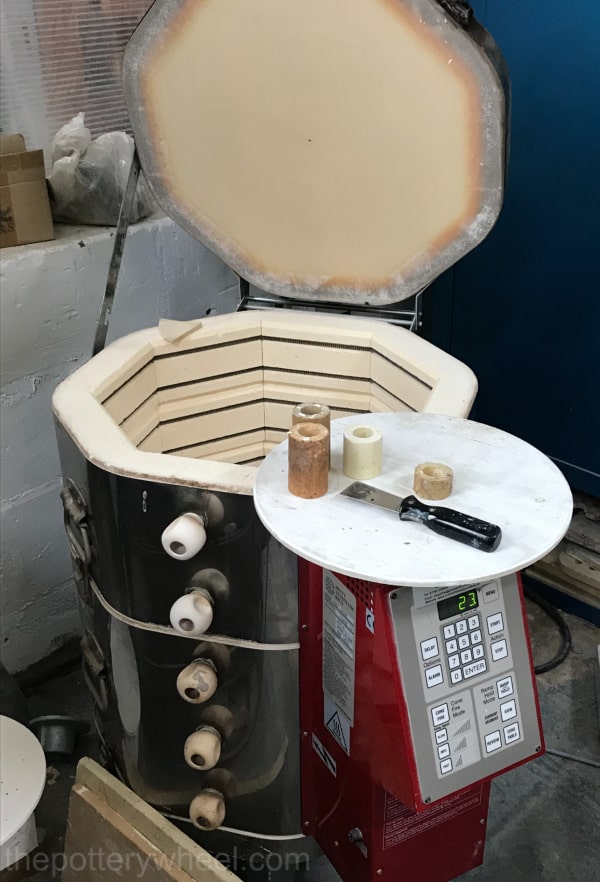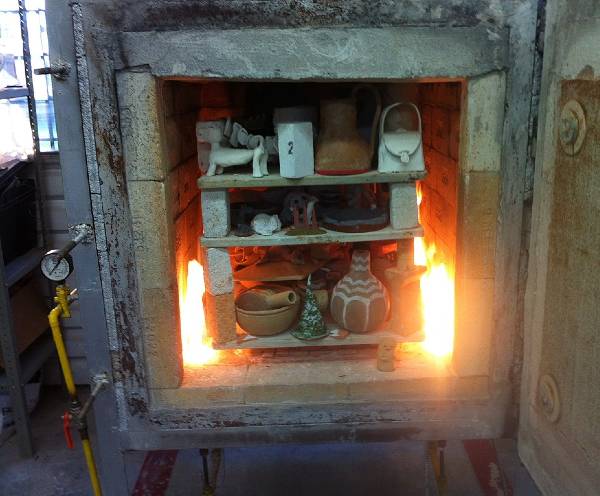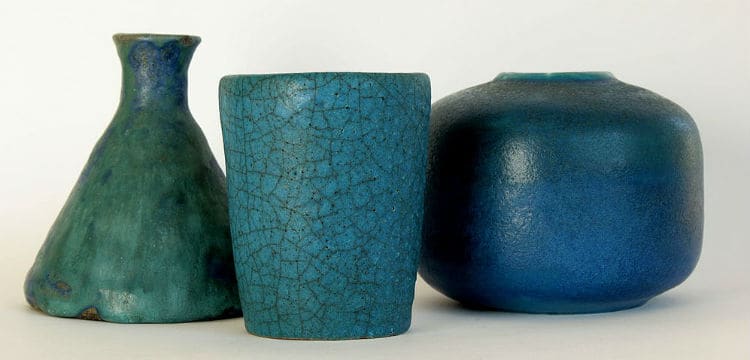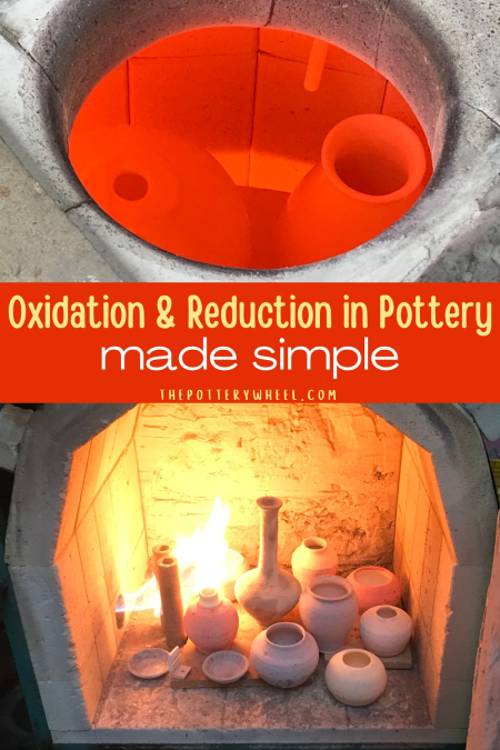Your cart is currently empty!
Oxidation and Reduction in Pottery – Made Simple!
Published:
Last Updated:

Affiliate Disclaimer
As an affiliate, we may earn a commission from qualifying purchases. We get commissions for purchases made through links on this website from Amazon and other third parties.
A lot of the articles and books about firing and glazes talk about oxidation and reduction firing. These terms sound scientific and off-putting. Because they are referring to chemical processes, they are complicated. So, I decided to write an account of them that is understandable to all of us ‘non-chemists’.
Oxidation occurs when there is an excess of oxygen. As the kiln’s heat increases, compounds in the glaze break off and oxygen attaches itself to the glaze and clay. This causes metals in both to oxidize. Reduction occurs when there is a deficit of oxygen. This deficit creates gases in the kiln, which leach oxygen out of the glaze and clay.
Oxidation and reduction are processes that glaze and clay go through. These processes are caused by conditions in the kiln. That is why potters also refer to oxidation and reduction “atmospheres” when firing.
Oxidation and Reduction – A Look at Oxidation First.
Oxidation is a chemical reaction between oxygen and metal. Glazes and clays both contain metal components, for example, copper carbonate and iron oxide.
When materials are heated in the presence of lots of oxygen, the metals in the materials often oxidize.
If a substance oxidizes, it undergoes a chemical change. It gains oxygen molecules and it loses electrons.
This chemical change alters its appearance. Think about the Statue of Liberty. The green color on the statue is oxidized copper. Similarly, rusted iron is the result of oxidation.
How Does Oxidation Work in a Kiln?
The same sort of oxidizing process happens to glazes and clay in the kiln. As the kiln heats up, compounds in the glaze and clay will start to break up.
For example, the carbon element of copper carbonate will separate off. During the firing process, carbon elements are driven out of the glaze and clay.
When carbon compounds break away from metals and minerals, oxygen will move in and take their place. In this example, copper carbonate becomes copper oxide.
The addition of oxygen to metals and minerals changes their appearance. Oxygen will often give glazes bright colors.
One metaphor is the addition of oxygen to blood. Oxygenated blood is bright red. Although this parallel may not be chemically accurate it’s a helpful way to remember the effect of oxygen on pottery.
In addition to this, oxygen has high electronegativity. This word can feel a bit off-putting and complicated. However, in simple terms, it means that oxygen attracts very small particles from other substances towards itself.
These small particles are electrons. When oxygen attaches itself to pottery in a kiln, it draws electrons from the glaze and clay. The transfer of electrons from a substance to oxygen is part of what is meant by oxidation.
An oxidation atmosphere in a kiln is one where there is excess oxygen. When oxygen combines with carbon it creates carbon dioxide. Carbon dioxide has two oxygen atoms for each carbon atom.
An oxygen-rich atmosphere is when there are more oxygen atoms available than are needed to create carbon dioxide.

Oxidation and Reduction – A Look at Reduction
Oxidation firing creates bright clean colors. By contrast reduction firing tends to create rich, organic, earthy colors. It can also give pottery a speckled appearance, as flecks of iron in the clay peep through the glaze.
In oxidation, excess oxygen attaches itself to the surface of the glaze and clay. It then interacts with the materials to create the resulting pottery surface.
By contrast, in a reduction atmosphere, oxygen is drawn out of the glaze and clay. It is the drawing out of oxygen that contributes to the appearance of the glaze once fired.

How Does Reduction Work In The Kiln?
Reduction firing is generally used in fuel-burning kilns. The reason for this is that the process generates gases that can damage the elements in an electric kiln. Although some potters manage to achieve reduction firing in an electric kiln, it is generally associated with gas or fuel-burning kilns.
What is Reduction Firing?
To create a reduced atmosphere, the relative amount of oxygen in the kiln is reduced. This can be done by increasing the amount of fuel present. Or restricting the amount of air going into the reduction kiln. This depends on what kind of kiln you are using.
In combustion, fuel is turned into heat energy. When there are two atoms of oxygen for every one atom of carbon, all the fuel is converted during combustion. No fuel is wasted and all the oxygen is employed.
However, if the ratio of oxygen to carbon is less than 2:1, then the fuel is not burnt completely. There is not enough oxygen to completely convert the carbon to heat energy.
When this happens the flame becomes long, orange, and smoky. Furthermore, the leftover carbon converts to gases. These gases include carbon monoxide and hydrogen.
Carbon monoxide seeks out oxygen to convert back to carbon dioxide. Hydrogen needs oxygen to burn. As a result, the gases in the reduction atmosphere, draw oxygen out of the glaze and clay.
Because oxygen is being leached out of the pottery, the metals in the glaze and clay are reduced further. This accounts for the intense, sometimes dense look of glazes on reduction fired pottery.
Taking the example of copper again, in an oxidizing atmosphere it turns green. Think again of the Statue of Liberty. By contrast, it turns a rich red color in a reducing atmosphere.

Picture by Elvino. Autor: Wanda Golakowska (1901-1975), CC BY-SA 3.0, via Wikimedia Commons
What is a Neutral Atmosphere in Pottery?
Sometimes the atmosphere in a kiln is neither oxidizing nor reducing. Rather, it is neutral. This means that there is enough oxygen in the kiln for the fuel to burn completely without waste. However, there is not so much that there is an excess of oxygen.
In a neutral atmosphere, the magical ratio of two atoms of oxygen to one atom of carbon is achieved.
Some potters suggest that achieving a neutral atmosphere is difficult (source), particularly in a fuel-burning kiln. The reason for this is that it’s hard to balance out the presence of fuel and air perfectly in the extreme environment of a kiln.
Other potters claim that firing may be taking place in a more neutral atmosphere than is intended (source).
For example, an electric kiln may be thought to be in oxidation. However, there is less airflow in an electric kiln than in a gas kiln. Therefore, gases and carbon can build up in the atmosphere making the environment more neutral than intended.
As such, it’s thought that a neutral atmosphere is hard to achieve in a gas kiln. Whereas, it may be something that is stumbled upon unwittingly in an electric kiln.
Switching Between Oxidation and Reduction
Oxidation and reduction firing is not an either-or situation. Often potters will use a combination of both during a firing schedule. Some of the ways that potters will mix up their schedules are as follows:
- Creating a reduction atmosphere in the last firing stage, before the kiln is shut down.
- Starting in oxidation and at a couple of points during the fire, the kiln will be put into reduction.
- Putting the kiln into oxidation right at the end of a reduction fire. This can clear the atmosphere in the kiln and remove bubbles from the surface of the glaze caused by reduction.

Final Thoughts About Oxidation and Reduction
It’s helpful to have an understanding of the difference between oxidation and reduction in firing. These different processes have a significant impact on how your pottery will look once it has been fired.
You may well only have access to one particular kind of kiln, electric or fuel burning. This will make a difference to how your ware is likely to be fired.
I find it helpful to understand why clay and glaze go through their transformations in the kiln. Besides, looking into the chemistry of what is happening satisfies my inner nerd. I hope you have found it helpful too.



